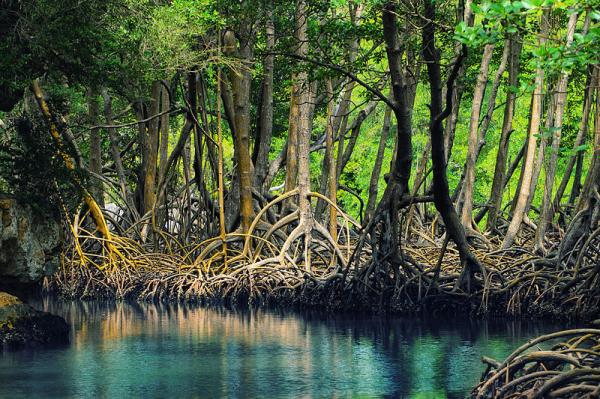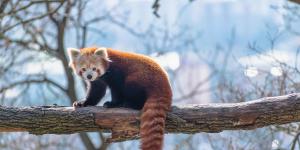Endangered Animals of the Mangrove Forests


The mangroves of the world are currently under threat; since mangroves are subtropical and tropical forests that grow in saline or brackish coasts, they are at risk because of climate change and water pollution, as well as changes in salinity.
In this article, we'll cover the animals that rely on mangroves for all or part of their lives as well as the flora associated with the mangroves themselves. These species are closely associated with each other and the wider ecosystem, forming a chain of sustenance which can break if even one species is lost.
Do you want to learn all about this enchanting habitat? Stay with us at AnimalWised and learn all about the endangered animals of the mangrove forests with examples and pictures.
Dugong
Known scientifically as the Dugong dugon and popularly as the "sea cow", this large mammal is found in mangrove forests as well as other shallow seas between East Africa and Vanuatu Islands west of Australia. The massive dugong is more closely related to the elephant rather than to any sea mammal.
The dugong is mostly an herbivorous animal, although it has fed on sea creatures as well. Habitat loss, degradation due to pollution and trawling, hunting for bones, and meat are some of the reasons their numbers are falling; today, the dugong is a vulnerable species. Additionally, the dugong plays a crucial role in maintaining the health of seagrass beds, which are vital ecosystems in their own right.

Pygmy Three-Toed Sloth
Known scientifically as the Bradypus pygmaeus, this critically endangered sloth is found off the Panama coast. This mangrove animal has the distinction of being the smallest sloth on planet Earth, as it's only 50 cm (20 in) long.
The pygmy three-toed sloth is found in the red mangrove forests surrounding the small island of Isla Escudo de Veraguas. It only feeds on leaves, and its population is said to be less than 500 individuals. The main threat for the pygmy three-toed sloth survival comes from the loss of habitat as people are encroaching on the mangroves, and hunters are also visiting the island. Conservationists are working to protect these sloths by establishing protected areas and promoting sustainable tourism.
Bengal Tiger
Scientifically called Panthera tigris tigris, the Bengal tiger is found chiefly in the mangrove forests of India's Sunderbans region. It is also found in Bhutan, Nepal, and Bangladesh.
This iconic species is estimated to be at less than 2500 individuals, although it is currently counted as the most prolific of all the types of tigers around the world. The Bengal tiger hunts large and medium-sized prey, and is under threat due to habitat degradation and poaching as well as hunting. Mangrove forests offer a unique habitat that provides both cover and a diverse range of prey for the Bengal tiger. Stay with us to learn exactly why are Bengal tigers endangered.

False Water Rat
Scientifically referred to as Xeromys myoides, this is a vulnerable species found in Papua New Guinea and Northern Territory as well as Queensland in Australia. Little is known about this small, nocturnal rodent.
The false water rat is a carnivore that feeds on crabs and shellfish, and it is found in mangrove roots when the tide recedes. It is only found in mangroves and associated coastal wetlands, and its numbers are falling. The species faces significant threats from habitat loss due to coastal development and pollution, and efforts are being made to study and preserve its natural environment.

Proboscis Monkey
Scientifically called Nasalis larvatus, this endangered monkey is a unique primate whose numbers are declining, and nowadays the proboscis monkey is an endangered species.
The proboscis monkey is found in Brunei, Indonesia, and Malaysia, and it is endemic to Borneo. This species is found in mangroves and riverine forests, and it has reddish fur. This monkey mainly eats leaves and fruits, but also consumes flowers and seeds. Habitat destruction is a major problem for the proboscis monkey, which is also hunted by locals for its meat and body parts. Protecting their habitat not only supports their population but also helps sustain the biodiversity of the mangrove ecosystems they inhabit.

Smooth-Coated Otter
Lutrogale perspicillata is its scientific name. This vulnerable species is a diurnal mammal, active in the morning and noon. It is rare in the wild now, but it can still be found in South and Southeast Asia.
The smooth-coated otter can reach up to 65 cm in length, and it inhabits riverine and mangrove estuaries. It is a carnivorous animal, as it eats fish, crustaceans, insects, birds, and amphibians. This marine mammal faces destruction from humans, excessive industrialization, pollution, prey loss, and indiscriminate killing. Preservation efforts focus on protecting their habitats and ensuring sustainable management of water resources.

Western Red Colobus
This endangered primate is scientifically called Procolobus badius. It is found in Africa, from Ghana to Senegal.
The Western Red Colobus is one of the endangered animals of mangrove forests, and like many others, it is herbivorous. Logging, indiscriminate destruction of forests and clearing lands for plantations as well as killing on account of this primate being bush meat are the reasons behind its decline. Conservationists emphasize the importance of protecting forests and promoting alternative livelihoods to reduce hunting pressure on this species.

These are the endangered animals of the mangrove forests around the world. Remember to do your best to protect their habitat and preserve them for the future! By supporting conservation efforts and raising awareness, we can help ensure that these unique ecosystems and their inhabitants thrive for generations to come.
If you want to read similar articles to Endangered Animals of the Mangrove Forests, we recommend you visit our Endangered animals category.






 Amazing! Don't dugongs feed in seagrass meadows?
Amazing! Don't dugongs feed in seagrass meadows?





